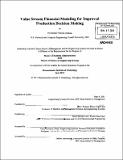Value stream financial modeling for improved production decision making
Author(s)
Hopkins, Christopher Warren
DownloadFull printable version (12.90Mb)
Other Contributors
Leaders for Global Operations Program.
Advisor
Roy Welsch and David Simchi-Levi.
Terms of use
Metadata
Show full item recordAbstract
Understanding the overall impact of a decision in a manufacturing system can be challenging given the complex production and financial structures in today's companies. While knowing the direct result of a local change may be easy, anticipating the real impact to the rest of the business can be difficult. Nonetheless, managers are faced with this dilemma on a regular basis as they try to support the larger organization, taking appropriate actions as best they can. Based on a project at Novartis Vaccines and Diagnostics for an influenza vaccine, this thesis helps address some of the key questions managers face. It discusses a technique for more accurately determining the implications of these common manufacturing decisions: * How much should be spent to improve a particular component? * What are the impacts of expanding into new markets? " Which parameters in the factory most deserve managerial attention? * What are the appropriate tradeoffs to make when deciding on materials purchasing? Using concepts from throughput accounting, a model is developed from a detailed cost structure analysis, linking the financial and production aspects of the system. Whenever a parameter is changed, the model simulates how the rest of the system would perform through a linear program that replicates the production scheduling process. Thus, a manager is able to experiment with the tool in order to observe the overall impact of the change being considered and levy a decision based on the anticipated costs and benefits projected by the model. As a result, managers can distribute resources in a more efficient manner and align decision making throughout the organization. This thesis discusses the modeling approach, historical validation and initial insights for the current system. It also covers techniques for future applications and identifies the underlying organizational challenges that must be addressed to achieve a global optimum.
Description
Thesis (M.B.A.)--Massachusetts Institute of Technology, Sloan School of Management; and, (S.M.)--Massachusetts Institute of Technology, Engineering Systems Division; in conjunction with the Leaders for Global Operations Program at MIT, 2011. Cataloged from PDF version of thesis. Includes bibliographical references (p. 78-79).
Date issued
2011Department
Leaders for Global Operations Program at MIT; Massachusetts Institute of Technology. Engineering Systems Division; Sloan School of ManagementPublisher
Massachusetts Institute of Technology
Keywords
Sloan School of Management., Engineering Systems Division., Leaders for Global Operations Program.